Udon noodles have been a staple of Japanese and other Asian cuisines for centuries.
Their versatility makes them an ideal pantry item to have on hand, as they can be used in many dishes, both sweet and savory.
However, it may only sometimes be feasible to acquire the traditional ingredients needed to make udon noodles yourself.
In today’s blog post, we’ll discuss some great options to substitute for udon noodles you can use in your favorite dishes.
We’ll go over why each alternative might be preferable depending on what sort of dish you are preparing.
What Are Udon Noodles?
Udon noodles are thick wheat-based Japanese noodles usually served in soups or cold salads.
They are made with flour, salt, and water and are chewy.
Udon noodles can be prepared quickly and easily, making them popular for quick meals.
They can also accompany other dishes, such as stir-fries, soups, and curries.
Udon noodles can be tossed into salads or topped with sauces and seasonings for a delicious meal.
They can even be boiled and served with vegetables or other ingredients for a heartier dish.
Additionally, udon noodles can make an excellent base for soups as they absorb flavors beautifully and hold their shape when cooked properly.
They are also excellent fried or served cold in salads. Udon noodles have a mild flavor that allows them to fit into many recipes.
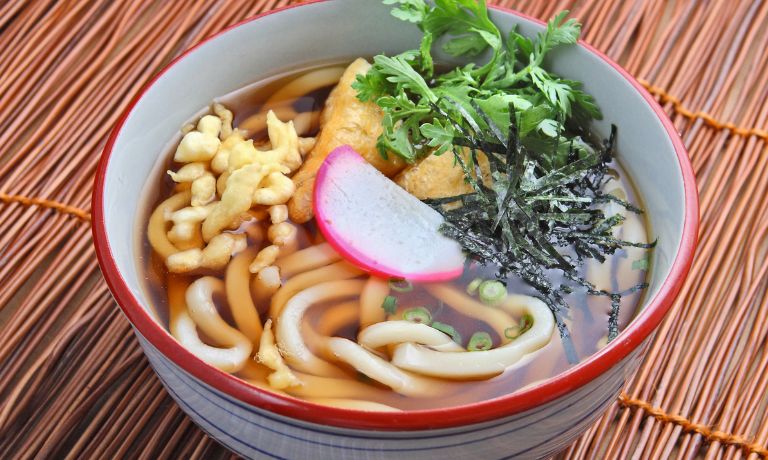
Substitutes For Udon Noodles
Plenty of delicious options are available if you’re looking for alternative options to Udon noodles.
Soba Noodles
Soba noodles, also known as buckwheat noodles, are a type of traditional Japanese noodle made from buckwheat flour and water.
They have a nutty flavor profile and a slightly chewy texture that works well in soups or stir-fry dishes.
[display-posts id=”2280″ image_size=”thumbnail” posts_per_page=”1″]
They can often be found packaged and sold fresh in many grocery stores.
Soba noodles can be a great substitute for udon noodles because of their similarities.
Both noodles are made with wheat flour and have similar texture profiles, so they work well in the same dishes.
The only difference is that buckwheat flour has a nutty flavor, giving the soba noodles an extra depth of flavor.
Additionally, soba noodles are usually a bit thinner than udon noodles, giving them a less bulky texture that can be more desirable for certain dishes.

Ramen Noodles
Ramen noodles are a type of Japanese noodle dish made from wheat flour, salt, water, and alkaline mineral water known as kansui.
Ramen noodles come in many varieties, such as thin or thick, straight or curly, and plain or flavored with spices and seasonings.
They can also be served cold or hot and are often served with vegetables, meats and sauces.
Ramen noodles can be used in various dishes such as stir-fries, soups, salads, and ramen bowls.
Furthermore, since they are thin and can be cooked quickly, they are perfect for busy weeknight meals.
Additionally, since they come in different flavors and varieties, there is more room for creativity when creating a dish with ramen noodles as the base.

Somen Noodles
Somen noodles are a type of thin, white Japanese wheat-flour noodle.
They can be used as an alternative to udon noodles in many dishes due to their similar texture and appearance.
[display-posts id=”2251″ image_size=”thumbnail” posts_per_page=”1″]
Somen noodles are often served cold with dipping sauces or hot in soups and stews.
They absorb flavors well, making them great for absorbing the flavor of the broth they are cooked in.
Somen noodles can also be stir-fried with vegetables and meats, creating a delicious and nutritious dish that is quickly prepared.
Additionally, somen noodles are low in calories and fat, making them an excellent option for healthy alternatives to udon noodles.
With their versatility and health benefits, somen noodles can be a delicious substitute for udon noodles in many dishes.
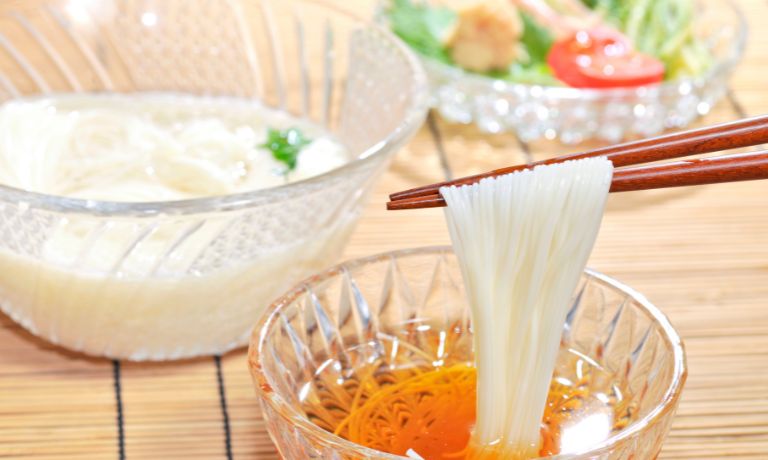
Egg Noodles
Egg noodles are a type of noodle made with egg, wheat flour, salt, and water.
They can be thin, flat noodles or thick and round like spaghetti.
Egg noodles have a smooth texture, often compared to udon noodles in cooking.
They work well in stir-fry dishes, soups, as a side dish, or as a main course.
Egg noodles are more accessible than udon and can be found in most grocery stores.
They also have a shorter cooking time than udon and can be a great substitute for those who don’t want to wait as long for their meal.
Egg noodles are also cheaper than udon, making them an affordable option for those on a budget.
Despite their similarities, egg noodles are less flavorful than udon and require more cooking seasoning.
In addition, while they have a similar texture to udon, their softer consistency can make them break down faster in longer cooking dishes like soups and braises.
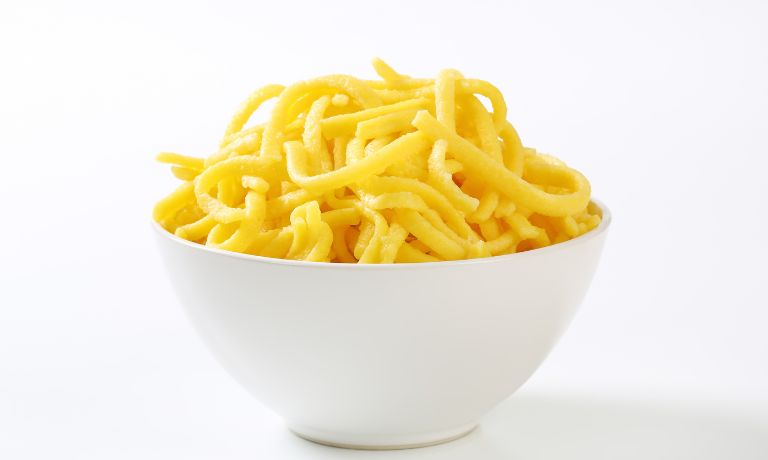
Rice Noodles
Rice noodles are thin strips of rice flour dough soaked in water and then steamed or boiled until they become soft.
They are popular in Southeast Asian cuisine, such as Thai, Vietnamese, and Chinese.
[display-posts id=”2223″ image_size=”thumbnail” posts_per_page=”1″]
Rice noodles have a lighter texture than udon noodles, which can benefit dishes requiring more delicate preparation.
They pairs well with various sauces and seasonings, making them a versatile ingredient for any meal.
They can also be the foundation for many soups and stews, adding a light and flavorful base.
Rice noodles can be cooked with vegetables, proteins, and herbs to create delicious dishes that are both healthy and satisfying.
With their flexibility and health benefits, rice noodles make an excellent alternative to udon noodles in any recipe.
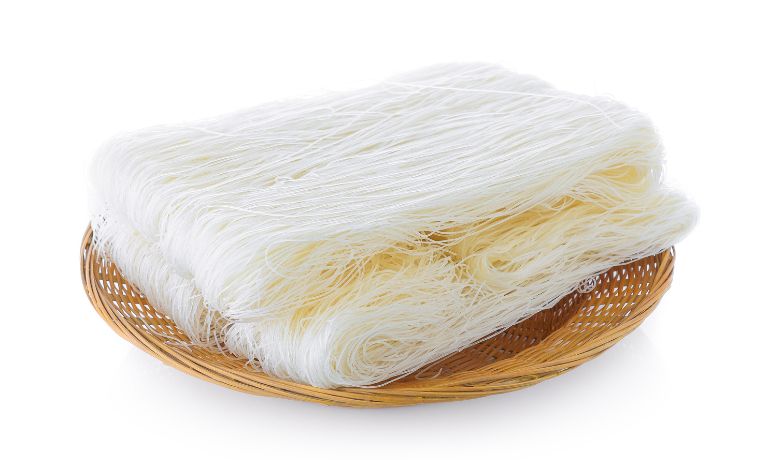
Shirataki Noodles
Shirataki noodles are low-calorie, gluten-free alternatives to udon noodles.
They are made from the root of the konjac plant, which is native to Asia.
Shirataki noodles have a unique texture and consistency, allowing them to be cooked in many ways.
They can be boiled, fried, or sautéed and used as an alternative to udon noodles.
Additionally, they contain fiber which helps promote digestion and regularity.
They also have no fat or cholesterol and are virtually carb-free.
These benefits make shirataki noodles a great alternative to udon noodles for those looking for a tasty, healthy substitute.
Finally, shirataki noodles are incredibly easy to cook and can be prepared in minutes.

Hiyamugi Noodles
Hiyamugi noodles are thin, white wheat-based noodles originating from Japan.
Traditionally used as an accompaniment to soups and stir-fries, they have become increasingly popular in the West as a substitute for udon noodles in many dishes.
[display-posts id=”2172″ image_size=”thumbnail” posts_per_page=”1″]
The texture of Hiyamugi noodles is softer than that of much thinner udon noodles.
This makes them perfect for absorbing flavors from sauces or soups and gives them a unique texture.
They cook relatively quickly, usually within two to three minutes, so they can be a great time-saving option for busy cooks.
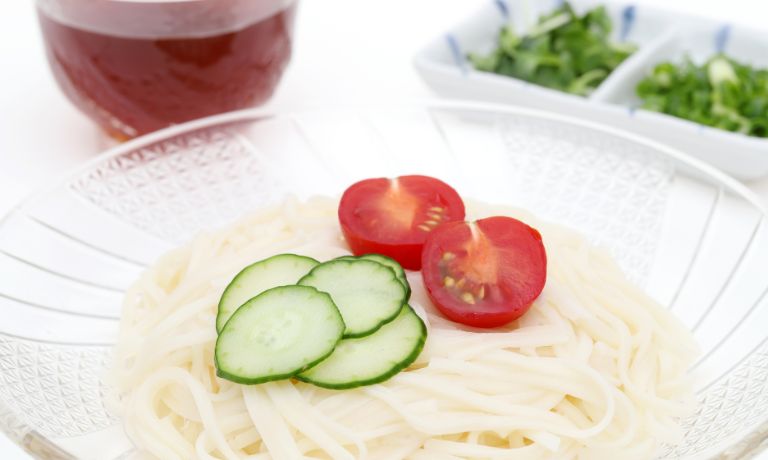
FAQs
Can You Substitute Egg Noodles With Udon Noodles?
Yes, you can substitute egg noodles with udon noodles.
Udon noodles are often used in Asian dishes, providing a chewy texture similar to traditional egg noodles.
However, the flavor of udon noodles will be slightly different than that of egg noodles.
Are Udon Noodles Good For You?
Udon noodles are generally a healthy choice.
They are low in fat and calories but provide a good source of carbohydrates, which help give you energy throughout the day.
Additionally, udon noodles can be high in fiber and protein, depending on your chosen type.
Are Ramen Noodles Similar To Udon Noodles?
No, ramen noodles and udon noodles are not the same.
Ramen noodles are made with wheat flour, salt, water, and kansui (alkaline mineral water), while udon noodles are made with wheat flour and salt only.
Conclusion
There are many options to substitute for udon noodles, each with a unique texture and flavor.
From egg noodles to rice noodles to shirataki and hiyamugi noodles, the options are seemingly endless.
Ultimately, it’s up to you which substitute you choose depending on your preference of taste and texture as well as any dietary restrictions or health goals you may have.
Whatever type of noodle you choose can be used to make delicious and nutritious meals.
So why not give them a try? You might just find your new favorite noodle dish!

